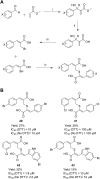Conformationally restricted calpain inhibitors
- PMID: 28757975
- PMCID: PMC5508670
- DOI: 10.1039/c5sc01158b
Conformationally restricted calpain inhibitors
Abstract
The cysteine protease calpain-I is linked to several diseases and is therefore a valuable target for inhibition. Selective inhibition of calpain-I has proved difficult as most compounds target the active site and inhibit a broad spectrum of cysteine proteases as well as other calpain isoforms. Selective inhibitors might not only be potential drugs but should act as tools to explore the physiological and pathophysiological roles of calpain-I. α-Mercaptoacrylic acid based calpain inhibitors are potent, cell permeable and selective inhibitors of calpain-I and calpain-II. These inhibitors target the calcium binding domain PEF(S) of calpain-I and -II. Here X-ray diffraction analysis of co-crystals of PEF(S) revealed that the disulfide form of an α-mercaptoacrylic acid bound within a hydrophobic groove that is also targeted by a calpastatin inhibitory region and made a greater number of favourable interactions with the protein than the reduced sulfhydryl form. Measurement of the inhibitory potency of the α-mercaptoacrylic acids and X-ray crystallography revealed that the IC50 values decreased significantly on oxidation as a consequence of the stereo-electronic properties of disulfide bonds that restrict rotation around the S-S bond. Consequently, thioether analogues inhibited calpain-I with potencies similar to those of the free sulfhydryl forms of α-mercaptoacrylic acids.
Figures






Similar articles
-
The structural basis of differential inhibition of human calpain by indole and phenyl α-mercaptoacrylic acids.J Struct Biol. 2014 Sep;187(3):236-241. doi: 10.1016/j.jsb.2014.07.004. Epub 2014 Jul 30. J Struct Biol. 2014. PMID: 25086406
-
Structure-based design of allosteric calpain-1 inhibitors populating a novel bioactivity space.Eur J Med Chem. 2018 Sep 5;157:1264-1275. doi: 10.1016/j.ejmech.2018.08.049. Epub 2018 Aug 23. Eur J Med Chem. 2018. PMID: 30195237
-
An update on the therapeutic potential of calpain inhibitors: a patent review.Expert Opin Ther Pat. 2020 Sep;30(9):659-675. doi: 10.1080/13543776.2020.1797678. Epub 2020 Aug 25. Expert Opin Ther Pat. 2020. PMID: 32700591 Review.
-
Formation of the calpain-1/calpastatin complex promotes activation of calpain-1 under oxidizing conditions.J Anim Sci. 2024 Jan 3;102:skae135. doi: 10.1093/jas/skae135. J Anim Sci. 2024. PMID: 38738874 Free PMC article.
-
A survey of calpain inhibitors.Curr Med Chem. 2000 Dec;7(12):1171-88. doi: 10.2174/0929867003374129. Curr Med Chem. 2000. PMID: 11032966 Review.
Cited by
-
An unexpected co-crystal structure of the calpain PEF(S) domain with Hfq reveals a potential chaperone function of Hfq.Acta Crystallogr F Struct Biol Commun. 2020 Feb 1;76(Pt 2):81-85. doi: 10.1107/S2053230X20001181. Epub 2020 Feb 5. Acta Crystallogr F Struct Biol Commun. 2020. PMID: 32039889 Free PMC article.
-
Neutrophil Cell Shape Change: Mechanism and Signalling during Cell Spreading and Phagocytosis.Int J Mol Sci. 2019 Mar 19;20(6):1383. doi: 10.3390/ijms20061383. Int J Mol Sci. 2019. PMID: 30893856 Free PMC article. Review.
References
Grants and funding
LinkOut - more resources
Full Text Sources
Other Literature Sources

